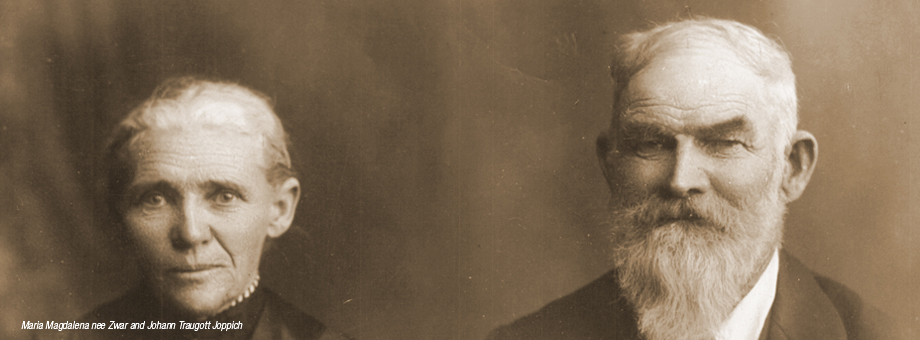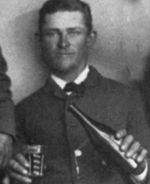
Peter Traugott Zwar (C6)
- Born: 28th November 1866 Ebenezer, South Australia
- Parents:
Peter and Magdalena Zwar nee Petzold - Caroline Wilhelmine Wandke
- Lived:
Ebenezer, St Kitts, Appila, Wirrabara, Caltowie, South Australia - Died: 23rd March 1955 Laura, South Australia
- Buried:
- Married:
Detailed biography
Sixth Child and fourth son of Peter and Magdalena Zwar 28.11.1866 – 23.3.1955
Childhood
Peter was baptized on 4 Dec 1866 by Pastor Maschmedt. Godparents: Christiane Schneider (later married Mickan), W. Steinert , G. Kleinig . When he was 5 years old Peter moved from Ebenezer to St. Kitts where his father had built their new home [It is still standing, though now unoccupied].
Peter attended the Lutheran Day School at St. Kitts under teachers Rechner and Klar and was confirmed 14.3.1880 in the church at Stockwell by Pastor Maschmedt. ConfirmationText John 21 verse 7.
Appila
Peter moved north to Appila three days after his confirmation. In a brief life story Peter mentions:
“Came to Appila March 17th 1880”.
Possibly his older brothers John and Andrew were already living there. Ernst had married in 1878 and he lived in the Barossa Valley.
Land
Their father Peter Snr had bought three pieces of land in the mid north of South Australia:
Section 99 – Booleroo – in 1877, and Section 209 Wirrabara from Menz on 3.11.1879 (cf. Wirrabara Book) and sections 110 and 131 – Appila on 17.6.1880.
[It is possible but unlikely the rest of the family only moved north in 1881 – cf. Magdalena’s obituary. Peter had sold the St Kitts property in Feb 1880. I think Jack [Jacob] mentioned in a note he went to Appila in 1878.)
Blacksmith
Peter was a qualified blacksmith or wheelwright, but I do not know where he served his apprenticeship and learnt his trade. He was about 14 or 15 years old when he moved north. It was most likely he learnt his trade at Caltowie with the blacksmith Steicke, but it could have been at Wirrabara with Wiley. His son Edgar said his father often spoke about the blacksmith at Caltowie.
Caroline Welhalmine Wandke
Peter met Caroline when she went to Appila to work for her sister, who had married a Jaeschke. Her family lived in the Adelaide Hills at Western Flat, between Mt Barker and Echunga, nearer the Echunga end. […from Reg Butler. Local historian].
Caroline was the third of six children born to Johann Friedrich Wilhelm Wandke (born 30.1.1834 at Leitersdorf, Germany. Died 8th May 1902) and his wife, Maria Elisabeth Wandke nee Kaläue (born 13.3.1834 at Leutnitz, Germany. Died 18.1.1909).
Caroline Welhalmine Wandke was born 9.2.1867 at Lobethal in South Australia and baptized there by Pastor Krause 24.2.1867, and was confirmed 30.11.1879 by Pastor J.M.R. Ey. Text Romans 3.28.
She worked in Balfours cake shop in Rundle Street in Adelaide before she married.
“She learnt to make the good pastry. She was a great cook and her 2 daughters are too” – Ed Zwar.
Caroline became known as “Minna”. Minna signed her name clearly as “Caroline Welhalmine Wandke” so I have used this spelling. Sometimes her name has been given in different spellings.
Marriage
Minna and Peter were married at Hahndorf in the Adelaide Hills on 9th February 1894 (her birthday) when they were both 27 years old. Pastor Strempel married them.
Text: Romans 12.12
Hymn: 1899
Witnesses: W. Wandke, farmer, living near Mt. Barker
, C. Wandke, farmer, living near Mt. Barker,
Pauline Boerke (Hahndorf).
Kevin Peter Zwar, a grandson, now wears Peter’s wedding ring.
Wirrabara
Minna and Peter lived at Wirrabara for about 5 years (from Peter’s Lebenslauf / Lifestory) in about a four roomed house just across from where Agnes & Emil Borgas’ later lived. [Later this land was bought by Heaslips. The house is long gone – Ed Zwar. Gwenda Obst – “We called it Fogdens”.]
His parents Peter Zwar Snr and Magdalena lived in the same house for a time after 1905. I understand that Peter had built it years earlier. It had a thatched / straw roof. Agnes was born in this house.
“Mum said I cried all the way to the church [for my baptism] and home again, and then I slept when I was put in the crib.” … Agnes.
Caltowie
According to the ‘Lebenslauf’ they next lived at Caltowie. ‘The Laura Standard’ reported on page 3 of Fri 17th November 1899 that
“C. Kentish had asked for rates to be collected from P. Zwar who was now renting his farm.”
They would have moved there in 1899. It seems Peter leased it for five years from Kentish, took out another lease for five years, and then he bought it. We don’t have written records of the first lease.
Two copies of the full lease still exist, stating that Peter leased section 364 of Caltowie from Charles Kentish of Clarence Park (Adelaide) containing 569 acres on 1 March 1904 with the option to buy. ( £200 deposit 3 pounds per acre) plus £1507 balance, plus extra for the blacksmith’s shop and 400 posts. It is most likely that Peter had already leased the property for five years. The farm was on the edge of the Caltowie Shire, but the postal address was always Laura, where they did their weekly shopping.
On 10th November 1908 Peter Traugott Zwar bought a three cornered paddock of 104 acres from Henry Hannett. It was sold to Edgar Heinrich Zwar on 5th June 1930 – a few months before his marriage, and to Glenn Zwar in 1975.
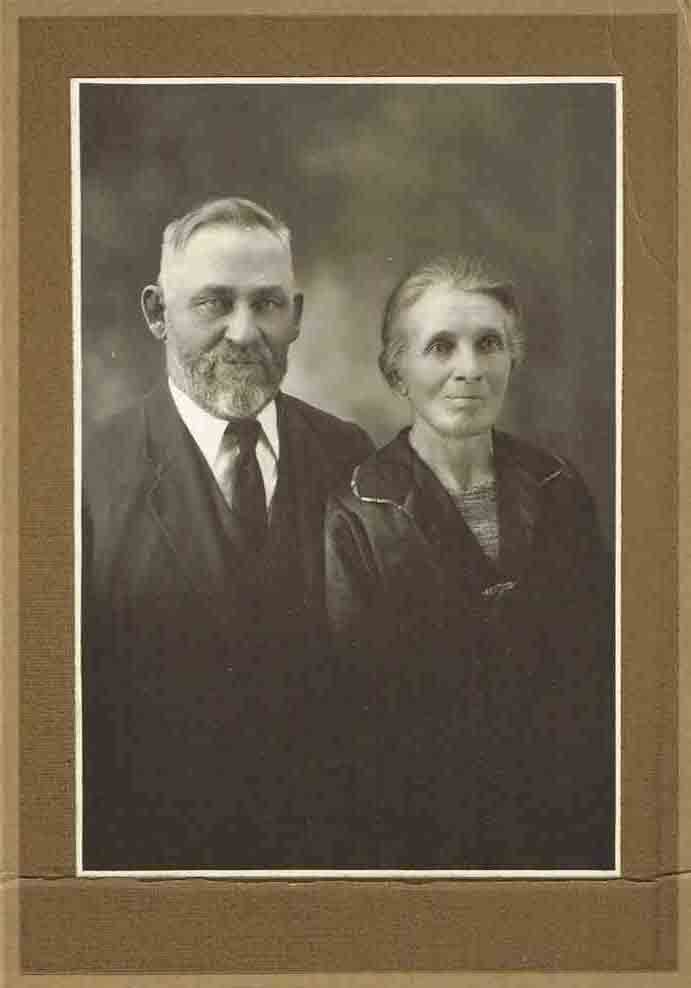
Peter and Minna Zwar
Home on the Farm
On 14th September 1908 the land was transferred from Charles Kentish to Peter Zwar. When they moved to the farm they lived in the second house. It had two main rooms with a verandah. They built on two more rooms on the western end and on the eastern side a long room that ran right along the verandah as a lean-to for the kitchen. The cellar was there, but just covered with dirt (ie. nothing built over it.). They extended the cellar and a builder named Maywald made it deeper and built a small storage room over the top.
The original house – or old hut – is where the working man now lived. It was a 2 roomed house. Peter built an extra room on the western end for the boys to sleep in. On the northern side Peter built on a buggy shed, and a blacksmith shop next to it.
Just before Edgar married in 1930 the builder Shepherd, from Laura, renovated the main house and put a new gable roof on it and plastered the outer walls. When Minna needed help one of the Altmann girls (her nieces) would come, either Tillie or Lydia. The children remembered their home near Wirrabara had a baking oven, but not not this one.
The “blacksmith-farmer”
Peter used to do a lot of blacksmith work when he lived on the farm. He was the blacksmith of the district, and a wheelwright. In the 1914 drought Edgar can remember 20 strippers standing in a line at the blacksmith shop mainly to fix up their wheels. Sometimes his daughters had to pump the bellows. The children were fascinated to watch Peter weld iron together.
“Peter was no farmer.” [son Ed Z]. “He was a blacksmith who lived on a farm.”
The girls had to work on the farm at harvest time too.
“We worked stooking hay, loading it, and carting the wheat.” .. Agnes and Mary. “Father sent me to help the neighbour too because he was loading on his own!” …Mary.
Albert Nayda (from Appila) worked for Peter for years as the farmhand until the children grew up. He loved to play cards. He lived in the ‘hut’ – the original house on the place- next to the blacksmith shop.
“He looked after the horses so well he nearly slept in the stable with them. We all liked him.” [Ed Z.] “He’d bring his accordion. Alf learned to play from him and played a lot for parties and functions.”
Church and Picnic
The annual church picnic was their big social day! In the early days it was held by the Pine Creek, down from the Church and near the crossing. Later it was held at Becker’s scrub in the nearby hills.
“We went to church by buggy – never missed. We’d go home from Church, change the horses, and go to Christenlehre [Youth Bible Study] one Sunday, and to choir the next. We went via Almond Tree corner.” [Ed Z]
First Car
“Our first car was bought in 1924, a Buick 4, and Father (Peter) drove it, and no one else for quite a while. It was white. The leather upholstery was ‘Zwar’ leather (from the Zwar cousins in Victoria -K.Z). We now had to drive to Church via Staker’s corner as it used to get too wet for the car on the flats over to Lange’s.” [Ed Z.]
Sharefarmer
Peter share-farmed land for Davidson (1914), who was a bachelor. Then he share-farmed land for Kargers, and then for Westons. He also share-farmed for Traugott Pech for some years. The land hadn’t been worked and the first year they got 8 – 10 bags an acre.
Peter was the first person in the district to buy an eight foot Sun header. He bought for £220.
Peter worked the Wirrabara land too. Alf and Ed would walk a plough and horses to Wirrabara and stay there for a week or so. Alf had a five furrow plough and seven or eight horses, and Ed a three furrow plough and five or six horses. The horses would get footsore from the stony ground. They had several good crops there as it was virgin soil and had a higher rainfall than Laura/Caltowie.
Yardmaster
Peter was the Yardmaster (Property Supervisor) at the Pine Creek Lutheran Church for 25 years, from 1909 until 1942. Quiet and reserved by nature, he was happiest when he was using his skilful hands to repair a piece of equipment for the Church or for his neighbours.
“Peter couldn’t speak a lot of English, but better than many. He met Traugott Pech in the street in Laura one day during the First World War and they spoke together in German. Someone tapped them on the shoulder and told them to go home”. [Ed Z.]
Minna
Minna did the shopping on Fridays in Laura. She took the buggy in to town. She took in butter and eggs to sell. She potted a lot of butter for the baker. She was a good cook and entered produce in the Laura show. Bread, butter, cake, poultry.
“We were never short of anything to eat. We had lots of fowls, sheep and pigs.” [Ed Z.]
Double Tragedy
Minna experienced a terrible tragedy on 8th April 1900. She was nearing the time for the birth of her fourth child. Her mother-in-law Lena Zwar had come to be with her and to be the midwife. Her 3 children Agnes, Herman and Alfred were playing in the barn among a heap of fertiliser bags when the bags caved in and Herman (aged 4 years 10 months) was killed. Her husband Peter was not home at the time, and Minna and Lena had to cope with the tragedy. The shock brought on the premature birth of Oscar, who died 13 days later. Minna suffered a nervous breakdown and was not well for some time. The Advertiser newspaper reported:
APILLA, April 18 – A fatal accident happened – a few days ago on the farm of Mr. Peter Zwar, jun., when his eldest child, a boy five years old, was killed. The children were sent to the haystack to play, and had been away only about five minutes. When the mother became anxious and, as she was ill in bed, sent the grandmother to see to them. The grandmother found them in the barn, where she got a terrible shock; a lot of manure which was stacked in bags had slipped and fallen on two of the children. The little boy’s legs only were to be seen. When he was taken out it was found that his neck was broken. His little sister, who was partly covered, escaped with a few scratches. The fatality is rendered more painful as an infant son was born in the home about the same time.”
The Laura Standard
Fri 13th April 1900
FATAL ACCIDENT — On Sunday last a sad accident occurred at the residence of Mr P. T. Zwar, Caltowie extension. Mr Zwar had occasion to leave home for the purpose of getting assistance in the household duties during his wife’s illness, and left his mother in charge of the patient. Shortly after two of his children – one a boy of about five years of age and the other a girl about three years were playing in a shed near the house where 83 bags of manure were stacked. They made a hole in one of the lower bags, causing the manure to run out, and those on top fell over, killing the little boy – Hermann Wilhelm. The other child had its head underneath a bag, but was unhurt. Much sympathy is felt for the bereaved parents.
Life for their children
They went to the Pine Creek school weekdays, and to church on Sundays by horse and cart via Almond Tree corner. On the way to school they picked up Lange’s and Wurst’s and there were about 6 or 7 children on the cart. It was a solid cart.
The children went to the Pine Creek Lutheran School until the first World War. When the government closed the Lutheran schools the Zwar children went to the Stone Hut Public School. Marie went to Stone Hut for the last few months of her schooling. Edgar went to Stone Hut school for 9 months for the last of his schooling. Smith was the teacher.
“He pulled our hair. We had ours cut short so he couldn’t grip it. Others felt sorry for me as I knew little English, and they helped me a lot. I learnt more in the 9 months there than ever before. Saegenschnitters went there too.” [Ed Zwar]
Ed also recalled:
“When I came home from School my pet kangaroo used to wait at the creek and then he’d race me home. I was riding a pony. The horse that took us to the Appila (Pine Creek) school was called Nellie. It was about 22 years old and used to take us two hours to get there.”
When Edgar finished school he went to confirmation classes. He said he’d like to be a pastor. His father Peter said,
“That’s only for Pastor’s sons, not farmers. You’d be better off to go on the road and crack stones.”
Peter and Minna always spoke German at home. The children did not learn to speak English until they went to the Stone Hut school during the first World War. All the children stayed home after their schooling finished.
“We had lots of cows to milk (by hand) – about 8 to 12. The horses to feed.” [Ed Zwar]
Weddings
The Silver Wedding of Peter and Minna was celebrated on the farm in 1919. A photo shows the numerous relatives and friends posing outside the house. The silver wedding dinner was held in the barn that had been built just in time to host the celebrations. cf. photo’s of the celebrations/cake.
“The barn was built with pine from the farm at Wirrabara. We sawed the logs ourselves. It was built (before the silver wedding) – about the end of the War.” [Ed Zwar]
Of Minna and Peter’s children, Alf was the first married (1924). In 1925 Agnes married and Marie in 1927. Edgar lived at home with his parents for a while and then he batched for some weeks after his parents moved to the Laura blocks on 14th August in 1930. Edgar married in October 1930.
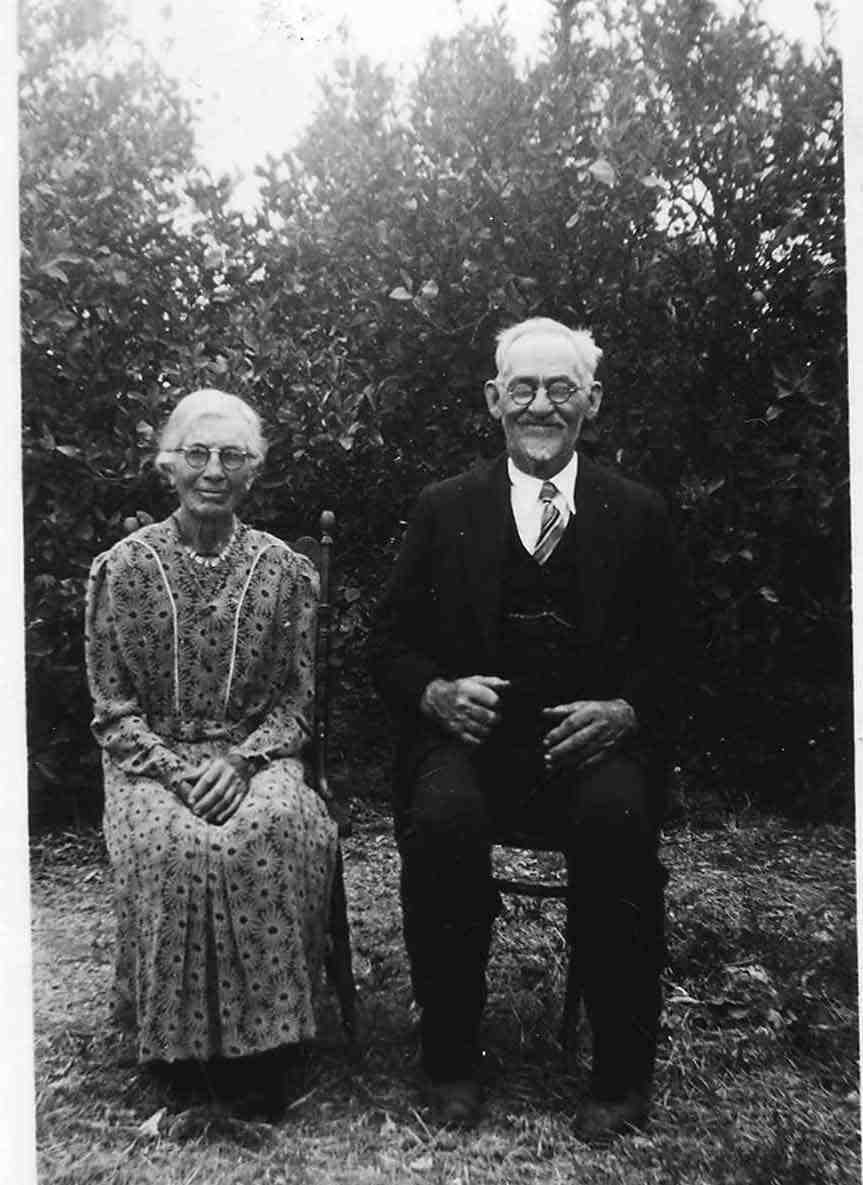
Minna and Peter Zwar 1943
Retirement in LauraPeter and Minna lived on the Laura blocks for the rest of their lives. Minna owned the land. They originally bought it from Hill with money she inherited from her parents. Different people had rented it for years. Her brother Fred Wandke (married Altmann) lived there for a time. She had 3 or 4 cows for a time.
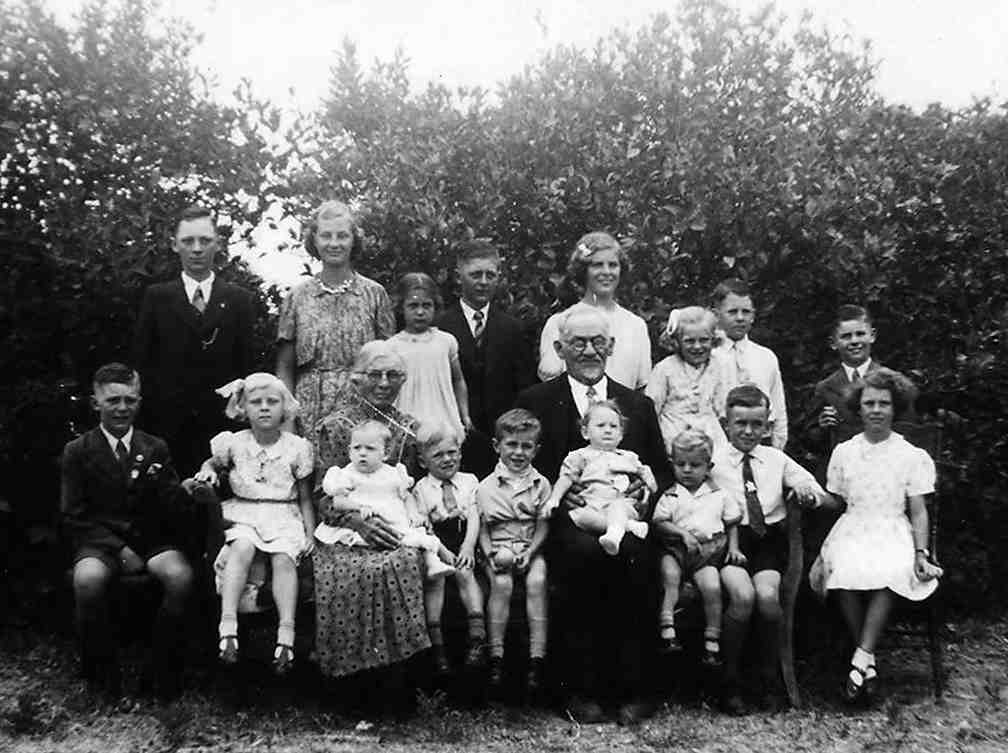
Minna and Peter Zwar and grandchildren 1943
When he retired to the Laura blocks Peter did odd jobs for people. He had his blacksmith there. Peter went to a lot of clearing sales and bought scrap metal to mend other people’s broken down machinery. They also grew a lot of vegetables in the first years and lots of citrus fruit trees. There was a huge mulberry tree near the kitchen.
Daughter Marie and FamilyOn the Laura blocks where Peter and Minna retired their daughter Maria lived several hundred metres nearby and helped them a lot. Marie and Herb Schultz had even lived with her parents for a while until they bought their own house close by.
Kenneth Schultz recalls,
“I lived with Grandfather Zwar for a while, and helped to cook for him. The neighbour, Mick Coles grew vegetables for sale around Laura, and Grandfather would help to wash the carrots. Grandfather made a shower out of a kerosene tin, by drilling holes in the bottom. He then poured a bucket of water into it for a quick shower.
When it was time for bed, Grandfather would say his prayers by kneeling at his bedside every night.”
Glen Schultz shared the following:
“We loved our Grandfather and sometimes stood in awe of him. He always needed to be early when he went to church, so while we lived with him, and so that we got the message, he would sit in the car, at least 15 minutes before departure time, wearing his dust coat, and wait for us. That made us hurry along.
I recall also that he owned a large stand up cabinet battery Radio. It stood on the dresser in the hallway outside the kitchen. He was unable to fathom the technology, but he was always ready to listen to the midday and evening news. That was the only time we heard the radio. All other programs were rubbish to him and may be even ‘of the devil’. While we did not like some of the boundaries he set, after all it was his home, and we learned to treasure his values.”
Death of Welhalmina
Welhalmina died 2nd May 1943, aged 76 years.
“Mother grew weak and died. The doctors (two, one from Jamestown) said she had a lump in her right side – near the appendix – it had been an injury, healed, and later may have become cancerous – a growth.” (Her daughters).
The Newspaper reported:
“ZWAR.- On May 2, at Laura Hospital,
Caroline Wilhelmine, beloved wife of P.
T. Zwar, of Laura, and loving mother of
Agnes, Alf., Marie, and Edgar, aged 76.
(Asleep in Jesus.)”
The Late Mrs. P. T. Zwar.
“The death occurred on Sunday, May 2, 1943, of Mrs Caroline Wilhelmine Zwar, at her residence, Laura Blocks at the age of 76 years. She was a daughter of the late Mr. and Mrs Wandke.
The deceased was born at Tweedsvale on February 9, 1867, after spending most of her youth in the Mt. Barker district she came to stay with her sister, Mrs. E. Jaeschke in the Appila district. On February 9, 1994, she was married at Hahndorf to Peter Traugott Zwar; after their marriage they resided at Wirrabara for five years, then purchased a farming property in the Hundred of Caltowie, where they were engaged in farming pursuits for 30 years. In 1930 they came to retire on the Laura Blocks.
She was a member and an ardent worker of the Lutheran Church all her life, and was a good faithful wife and a loving mother. Her quiet and friendly nature won for her a large circle of friends.
She is survived by her husband, two sons, Messrs. Alfred (Wirrabara) Edgar (Hundred of Caltowie) and two daughters, Mesdames F. E. Borgas (Wirrabara) and Herb. Schultz (Laura); two sisters, Mesdames E Jaeschke (Waikerie) and G. Klemm. (Narromine, N.S.W.).
She was buried in the Pine Creek Cemetery on Monday. Pastor W. F. Roehrs officiated.”
Final Years
Peter now lived on his own. His daughter Marie lived close by and she and her family looked after him a lot in his final years. A granddaughter Verna Fiedler nee Schultz recalls,
“For the rest of grandfather’s life we helped to look after him. We took Grandfather to the Pine Creek Lutheran Church every Sunday. He always wore his dust coat to Church to keep his suit free of dust from the dirt roads.
Mum cooked him a nice hot meal every day. Us kids would take it in turns to carry his meal across the small paddock. Once or twice it was dropped on the way, however we hoped he never noticed!!!
We would often find him sitting on his old miners couch under the back verandah waiting for us. As a reward he gave us lollies from his big lolly jar. We replied with “Dankeshön”, meaning ‘Thankyou” as he mainly spoke German.”
Myra Fechner nee Schultz added, “Grandfather would give us two shillings to buy more ‘penny’ lollies to put in his jar. We were not allowed to put them in the jar for him as he would count them to make sure there really was 24.”
Mr Fixit
Glen Schulz remembers,
“Not only did we cross the paddocks with his lunch, but also with our broken toys. Being a blacksmith, he was able to mend out toys and bikes in a way that they never broke again. No matter how big or small, he would try to fix it. We sometimes watched him at work on his forge and anvil as he shaped a spare part. Maurice learned skills from him which were valuable to him on his farm later in life. From toys and bikes to pitch fork handles grandfather could fix it. We treasured him for all that.
At the same time our shoes would wear through soles and Grandfather was always ready to fix them. He always had a supply of leather which he would cut with his knife sharpened not only on the sandstone but with the leather strap used for sharpening his cut throat razor. Then he threw the leather into water to soften it, placed the shoe on his shoe-lasp, mould the leather to the shape of the shoe while tacking it firm. For us that was fun to watch as he worked with a skill that we were keen to learn from him. No matter whether it was a school shoe – work boot – or delicate female shoe, he was always willing to put a new walking surface on them. We were grateful to him for that as it extended the life of our foot wear significantly.“ …Glen Schultz
Gladys Schild nee Schultz remembers
Grandfather made many toys for his grandchildren, such as 3 wheeler bikes and 4 wheel wagons. Often the wagon wheels were made from shoe polish tins. Then Kenneth would put Gladys in the wagon and pull her round the house yard, often on a slight slope. Grandfather enjoyed watching the grandchildren play.
Care
Peter’s other children helped to look after Peter too in various ways but it was not as convenient as they did not live close by. His neighbours would take Peter to the Pine Creek Lutheran Church on Sundays when he would meet with his friends and some of his own family.
87 Years
Peter died on 23rd March 1955, aged 87 years.
“The night your grandfather Zwar died, Uncle Alf, Herb and Ed were at the bedside at his home reading Scripture texts, especially the hymns on the second article of the creed, including “Jesus Thy Blood and Righteousness” (in German)… About an hour or two before he died, suddenly his face lit up, and he called out “Das Licht, das Licht” [the light, the light] as if he could see a bright light we could not see. He was quite excited and we couldn’t see anything!” … Ed & Rita Zwar to Kevin Zwar.
© Kevin P Zwar
